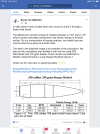You are using an out of date browser. It may not display this or other websites correctly.
You should upgrade or use an alternative browser.
You should upgrade or use an alternative browser.
Bullet RPM and performance
- Thread starter Darryle
- Start date
 Help Support Long Range Hunting Forum
Help Support Long Range Hunting Forum
This is interesting, I never thought about the spin terminal performance that way but it makes sense and would explain a lot of the penciling or inconsistent opening. Also another plus for spinning faster. Litz and Foster I think both comment on stabilization affecting terminal performance if I am remembering correctly.I think many of the stories of bullets failing to open and deform for proper terminal performance are not bullet failures, but a failure to have enough stability to keep the bullet point on long enough to get fluid into the hollow point to cause the bullet to open from the inside out. If a bullet impacts with a yaw then it is much more likely that it will not get fluid into the hollow point for proper deformation. Tipped, exposed lead, or open hollow point, are all hollow points. The tip is a plug in the hole that must evacuate to allow fluid in to cause opening from the inside out. Exposed lead tip basically has fluid already in the hole. Just needs point on pressure to cause the lead to become liquid and cause the inside out opening. This is likely the easiest to deform depending on lead hardness and jacket. Then the exposed open hollow point. Size of hollow point and material hardness will dictate consistency of opening. The smaller the hollow point the more critical the angle of impact to get fluid into the hollow point. 1mm hollow point we found too inconsistent to market as a hunting bullet.
For us the chase for higher bc is hard to resist. We are long range hunters. We continue to test but will not sacrifice terminal performance for anything. We will be doing some more tip testing soon. To date we have yet to find a tip that will perform as well at low velocity as the open hollow point. Why have a higher bc bullet that will not perform at as low of impact velocity? You are better off running the consistent performing open hollow point with lower bc that will perform at lower velocity. High bc bullet that needs more velocity to open reducing it's range is counter productive. Let alone the risk of the tip not evacuating the hollow point at higher velocity increasing the chance of failure compared to an open hollow point. Keeping the chance of failure as low as possible is most important.
I hope that someday I will have to eat crow when it comes to tipped bullets. I am not holding my breathe.
RockyMtnMT
Official LRH Sponsor
The amount of energy is not major contributor to terminal performance. Impact velocity, and bullet performance is what makes a permanent would channel. Bullet performance is dependant on it's stability. Higher stability insures better/proper bullet performance.That kind of shows the point that rotational energy doesnt add anything. There is less than 20ft-lbs on a 4000 ft-lbs cartridge.
As far as energy goes that is another myth. It is a nice number for comparing cartridges beyond that it it pretty arbitrary. Lots of energy with a bullet that explodes with little penetration is useless. Lots of energy with a bullet that penciled is almost as useless.
Well yes and no. Energy is ability to do work. There is no terminal performance without it. I can throw one of your bullets at a deer and it is not going to do much. What your bullet does with the energy is terminal performance. The reason we like to say energy doesn't matter is in general we have an abundance to do the work needed. Adding or removing a couple hundred ft-lbs once you have enough to do the job doesnt matter. My point is there is not much energy to do anything with despite the claims twist somehow increases killing power
Lou
Lou
RockyMtnMT
Official LRH Sponsor
Killing power-no. Bullet performance-yes. That is what is being missed.Well yes and no. Energy is ability to do work. There is no terminal performance without it. I can throw one of your bullets at a deer and it is not going to do much. What your bullet does with the energy is terminal performance. The reason we like to say energy doesn't matter is in general we have an abundance to do the work needed. Adding or removing a couple hundred ft-lbs once you have enough to do the job doesnt matter. My point is there is not much energy to do anything with despite the claims twist somehow increases killing power
Lou
Try it. Try it and get back to us. I think you'll be surprised.despite the claims twist somehow increases killing power
Bullets being spun on the edge of cohesion can be made to vaporize upon coming into contact with tissue paper. It stands to reason that you could tune the RPM of a larger bullet to come apart inside an animal of any size. I've only done these types of experiments with varmints and predators, as I have had no reason to run light bullets spun hard in a big game cartridge. My shots tend to be long, and so light bullets do not interest me. However, it stands to reason it could be accomplished.
-----------
Follow on Instagram
Subscribe on YouTube
Amazon Affiliate

So unless you eat it (the toxic variety), how does a bullet kill without energy? They are inter-related along with other things. However a bullet has to have enough energy to do it's work but more does not necessarily kill faster other things being equal. So bullet rpm contributed basically nothing to the work a bullet does in killing as there is no energy there. Otherwise you have to have some energy to do something to begin with
Lou
Lou
Perhaps a video demonstration will help. You'll notice in the video below that there is a gray puff of smoke to accompany the chunks in some of the videos. That little gray puff could be witnessed when I shot paper at 100yds. The bullet was a 17cal being spun hard in a barrel designed for 30's. The forward momentum of the energy was delivered in an instant as the bullet comes apart. Were it to stay together, the energy transfer would be happening in a much longer period of time. The same principle that allows a slow object to pierce water, but a fast moving object gets obliterated on its surface.So unless you eat it (the toxic variety), how does a bullet kill without energy? They are inter-related along with other things. However a bullet has to have enough energy to do it's work but more does not necessarily kill faster other things being equal. So bullet rpm contributed basically nothing to the work a bullet does in killing as there is no energy there. Otherwise you have to have some energy to do something to begin with
Lou
A very pointed demonstration of this at 2:30 in the video.
Energy transfer over time is a critical factor. Same energy delivery on a significantly shorter time, is vastly more destructive. Drastic oversimplification, but you get the idea.
-----------
Follow on Instagram
Subscribe on YouTube
Amazon Affiliate

I think so. One way I was thinking about this is in a faster twist barrel you are zipping the fragments off in a shorter distance. This to me is probably why people report seeing more 'pop' when using faster twist barrels on prarie dogs. How that translates to big game killing I am not sure. I could see it go either way - fragmentation spread over longer path vs shorter. Probably depends where you hit it and how big the game is
Lou
Lou
jasent
Well-Known Member
That's greatly dependent on bullet constructionI think so. One way I was thinking about this is in a faster twist barrel you are zipping the fragments off in a shorter distance. This to me is probably why people report seeing more 'pop' when using faster twist barrels on prarie dogs. How that translates to big game killing I am not sure. I could see it go either way - fragmentation spread over longer path vs shorter. Probably depends where you hit it and how big the game is
Lou
Take my 210gr vld load for example. This is a bullet with a fragmenting rep. In my rifle it's spinning 274,500 rpm yet on a whitetail I still get a exit from 100 yards to 650.
Imo the type of rifling and quality of jacket material and thickness of said jacket and how the rifling engraved the bullet has more of affect on the poof than rpm. Poor jacket consistency with high rpm ya get the poof or explosive varmint stuff.
Like I said before I "over spin" everything I shoot. With Berger's and few hornady bullets I've shot no poof. No explosion on surface shots on big game.
Last edited:
Agree. I should have said whatever fragmenting is going to happen for a given bullet, potentially happens in a shorter depth with fast twist. In the case of a varmint bullet you get more fragmenting, in something like an aframe or barnes you get minimal or no fragmenting. Others are in between depending on how designed. I am not trying to say in any way that faster twist=shallow penetration or bullet blow up. Just thinking through how impacts terminal performance given my experience and others reports
Lou
Lou
Grumpy old man
Well-Known Member
What or whose bullets do you shoot? Obviously you shoot good products ,how bIf that was true it would affect the bc. Flying point up. Most of my shooting is well beyond 1000 yards yet the bullets hit where they should. I've read this too but I believe it's a myth. Every bullet I shoot is "over spun"
Much weight ?
